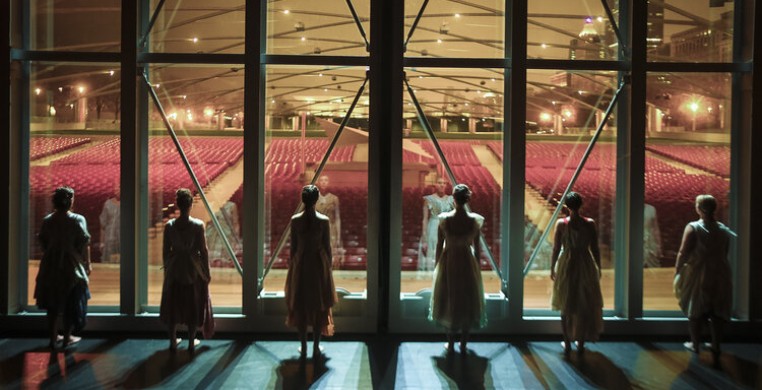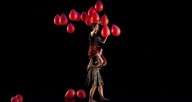Navigating new spaces—physical, psychological and political—is nothing new for the Space Movement Project (TSMP), but COVID-19 has thrust this troupe of six dancers into new spaces they had little expectation of exploring through dance: their own homes.
My first encounter with The Space Movement Project came on a Sunday afternoon as five women negotiated their own separate spaces in five isolated rectangles on my computer screen. Lauren Meadows, her hand resting lightly on her washing machine, was giving a ballet barre to company members Ashley Chung, Anne Kasdorf, Megan Schneeberger and Leah Raffanti.
Their physical environments were hardly conducive to dance. Ghostly figures floated in and out of the frames from doorways and distant hallways, a random child appeared and disappeared. Toys and toddler equipment lay scattered on the periphery just beyond the length of a leg extended in dévelopé.
While their geographic isolation from each other imposed a barrier to one of the most fundamental aspects of their improvisation-based work process, the familiar strains of recorded piano accompaniment and the ritual of pliés, tendus, ronds de jambes and grands battements worked their magic to wrap isolated bodies together in the all-encompassing embrace of the dancer’s barre. In this case, that barre may be a chair, the back of a sofa or a counter top.
The company would have celebrated its 15th anniversary with performances June 4-5 at the Hamlin Park Fieldhouse Theater. When the pandemic stuck, they had been developing a new collaborative work, “The Wall Dance,” set to premiere live at the anniversary performances. Instead, they launched video excerpts from past performances and footage of their rehearsal process developing “The Wall Dance” on their website, thespacemovementproject.org. Meanwhile, waiting out the pandemic, the company convenes via Zoom each Sunday for class and virtual rehearsal.
I asked the group how the altered conditions have affected them individually and as a company.
Their main concern is “to prioritize what matters,” Meghan Schneeberger said, “which is how to connect with audiences and with each other.”
Working as collaboratively and closely as TSMP does, Ashley Chung lamented, “you lose a lot of the benefits of seeing other dancers live. Me moving in a vacuum navigating space (at home) is a challenge.”
Anne Kasdorf agreed, “It’s a constant negotiation,” she said, citing the physical obstacles of walls and furniture and the needs of children and other family members.
Leah Raffanti said she gets “depressed about not seeing each other in person. (Lots of) energy shifts.” She misses the close contact of improvising together. With virtual rehearsing, “you can’t sense each other with the back of your legs.”
Schneeberger, who relocated to the East Coast, takes advantage of the diverse offerings of online classes. “While I’m stuck in a city where I didn’t enjoy the dance scene, now, almost everyone I like is teaching online. I can take from all my favorite teachers in Chicago, New York, and around the world.” She gravitates mostly to classes in guided improv and is especially happy to be studying spiral body technique with fellow Chicago dancer/choreographer Molly Shanahan.
As TSMP approached its anniversary year, the company had been going through considerable transitions, downsizing from ten members to four plus former members Shneeberger and Allyson Esposito, who return periodically for guest appearances.
“The company is evolving,” Chung said, citing a commitment to a “more honest and realistic” approach to their work and developing new ways of creating repertory.
“We wanted to strip away the production of it,” Raffanti said, “and focus on the process of moving together, learning how to listen to each other more.”
“We share roles as a collective,” added Kasdorf, who currently serves as company manager. Videotaping rehearsals lets them step back to look at and discuss their work together throughout the rehearsal process. “Entirely collaborative pieces take longer (to develop),” she said. “We take turns stepping out and being the objective eye. Watching is a huge part of the process.”
The slow, somatic movement style of that process owes much to the influence of Chicago dancer and choreographer Ayako Kato.
“We asked ourselves, ‘What would simultaneous solos look like?’” Raffanti continued. “Why do we do things that don’t feel good?”
Chung elaborated on the group’s effort to shed any ideology of what dance is supposed to look like. In developing “The Wall Dance,” they looked at ritual, both personal and societal, and what ritual means for community. They asked themselves questions about ancestry, family history and personal traumas and how these factors continue to resonate in their bodies.
In their improvisational sessions, there is always a “witness” or bystander who is part of the piece. “You can’t really check out,” Schneeberger said of the unique sense of group responsibility their collaboration has evolved. “All of us have important things to say," she added. “You maintain ownership for the work throughout rehearsal and performances.”
Most important is maintaining “ownership and agency of our own bodies in this artistic space,” she added. Working remotely, Shneeberger misses the in-person contact with her fellow artists. Her passion for the personal and artistic bond their work together has fostered veers emotional as she appreciates both the internal and external support it represents. “In this microcosm, everyone has a voice. It’s made us better citizens. Maybe (our work) can influence others to be better citizens, too.”
What’s next for The Space Movement Project? “We take everything in three-month chunks,” Kasdorf answered. For now, the July 26th "Barre at the Bar” was a virtual fundraiser. The next segment of “Dancing Families,” a series of informal, family-friendly performances takes place August 16. Beyond that? Sunday on-line class and rehearsal. For now, the company has no plans for developing new work expressly for virtual performance. Stay tuned.


